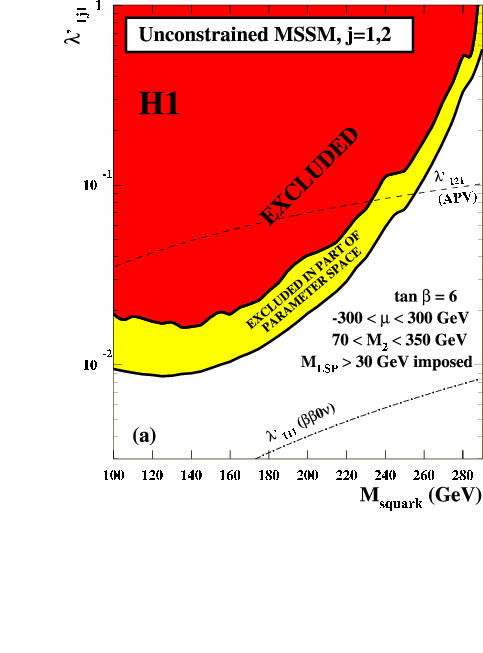One of the popular current theories explaining this ``higher'' symmetry is called supersymmetry or SUSY. SUSY theories have several consequences. One such consequence is that these 3 x 2 families (quarks and leptons) each have supersymmetric partner families, called squarks and sleptons. The quantity R-Parity is a quantum number which distinguishes between everyday particles and SUSY particles - the new particles introduced by SUSY have R-Parity = -1 and the known Standard Model particles all have R-Parity = +1. In many versions of SUSY, R-parity is conserved in particle interactions, i.e. the overall R-parity of the initial state has to match that of the final state. However, there is no strong underlying reason why R-parity conservation should be obeyed. If it is not conserved, reactions become possible in which two Standard Model particles can fuse to form a SUSY particle.
So R-Parity violating SUSY allows supersymmetric particles to be produced as resonances in high energy interactions of Standard Model particles, fleetingly exist and then decay back into Standard Model particles that could be observed in a detector. This possibility is what the publication "Search for Squark Production in R-Parity Violating Supersymmetry at HERA" examines. The HERA accelerator collides electrons and protons at higher energies than any other machine in the world. The presented work looks for evidence that the incoming electron and a quark from the incoming proton have briefly fused to form a squark, which can then decay via several different paths. The task is not an easy one, for many of the ways in which these squarks could decay are virtually indistinguishable from much more commonplace Standard Model processes that are studied at HERA.
The solution is to carefully compare the data collected in the detector with predictions for Standard Model and for SUSY processes. Small differences between the data and the Standard Model predictions for quantities such as the energies that the decay products have, the angle at which they are expected to be scattered into the detector or their masses are exploited. However, even after all this meticulous detective work, the conclusion is drawn that there is, as yet, no evidence for SUSY particles being produced at HERA. The story doesn't quite stop there however, because the analysis enables specific statements to be made about exactly which combinations of SUSY parameters can be ruled out. The plot below shows a graphical example of such limits, for the coupling lambda'1j1, which tells us for example how likely a positron and a down quark are to fuse into an up squark. The limits depend on the mass of the squark. The red region indicates combinations of couplings and squark masses that can be ruled out with reasonable (95%) confidence for all choices of other SUSY parameters considered. The yellow region shows the additional combinations which are ruled out for at least some choices of other SUSY parameters. It can be seen that the combinations of light squarks (small values of Msquark) and strong couplings (large values of lambda') are the easiest to rule out. Conversely, heavy squarks and weak couplings are the hardest to exclude. So there is no evidence for SUSY in the H1 data yet, but future data will extend the sensitivity into the white region in the bottom right-hand corner of the plot.

Last Update on 01/03/2004 by Nick
Malden